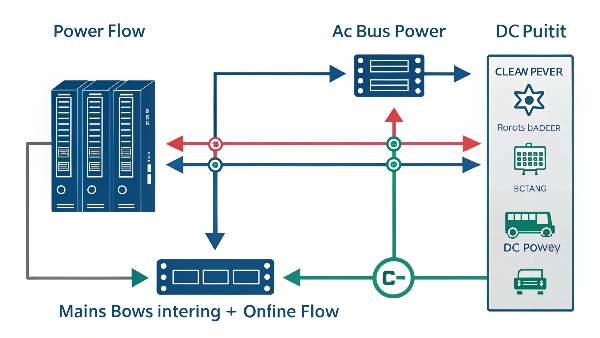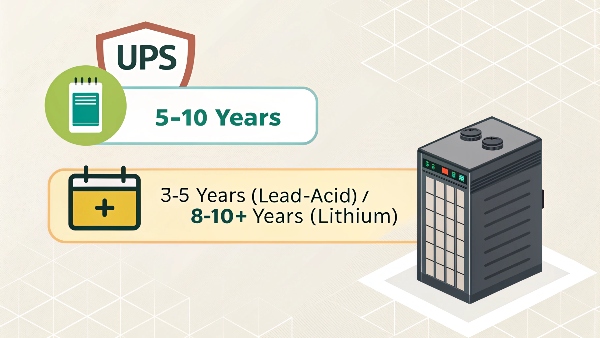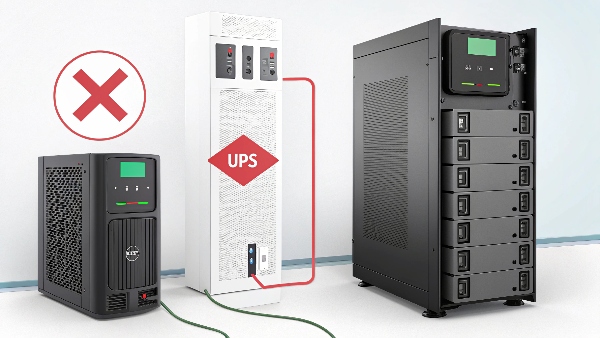Is your critical equipment vulnerable to power sags or blackouts? Unstable power can damage sensitive electronics and cause costly downtime. An online UPS offers a solution.
An online UPS system continuously powers your connected devices from its inverter, providing the highest level of protection. It converts incoming AC power to DC to charge its batteries and then converts it back to perfectly clean AC power for your equipment.

At DAOPULSE, we have been designing and manufacturing uninterruptible power supplies for a decade. We've seen firsthand how crucial reliable power is. My experience tells me that for applications demanding the absolute best protection, an online UPS is the gold standard. This type of UPS acts as an electronic firewall between the raw utility power and your valuable equipment, ensuring a constant, pure sine wave output. Let's explore this further.
What are the different types of UPS used in the market?
Choosing a UPS can seem complex. Different models offer various levels of protection. How do you know which UPS type fits your specific needs and budget?
The main UPS types are standby (offline), line-interactive, and online (double-conversion). Online UPS systems provide the most comprehensive protection, while line-interactive offers a balance, and standby is basic.

Understanding the fundamental differences between UPS types is key to making an informed decision. As a manufacturer, we produce various kinds to suit different client needs.
Standby (Offline) UPS
This is the most basic and usually the most affordable type. Under normal conditions, it passes utility power directly to your connected devices, offering some surge protection. When it detects a power problem (like an outage or a significant voltage drop), it quickly switches to its internal battery power. The main pros are its low cost and simple design. The cons include a brief transfer time (a few milliseconds) when switching to battery, which sensitive equipment might notice. Also, it doesn't actively condition power during normal operation, so minor fluctuations can still pass through.
Line-Interactive UPS
This type offers a step up in protection. Like a standby UPS, it normally passes utility power. However, it includes an Automatic Voltage Regulator (AVR). The AVR corrects minor power fluctuations (brownouts and swells) without switching to battery power. This reduces battery wear and provides better power quality. The pros are better voltage regulation than standby and a good balance of price and performance. The con is that it still has a short transfer time to battery during a full outage, though often faster than a standby unit.
Online (Double-Conversion) UPS
This is the type we are focusing on. It provides the highest level of power protection. The key difference is that the connected equipment always runs off the UPS's inverter, which reconstructs a perfect AC waveform from the battery (or rectified DC power). The incoming AC power is first converted to DC by a rectifier to charge the batteries and power the inverter. Then, the inverter converts this DC back to AC for the output. This "double conversion" completely isolates the load from raw utility power. The pros are zero transfer time to battery, the best power conditioning, and protection against nearly all power problems. The main con is usually a higher initial cost and slightly lower energy efficiency due to the constant power conversion.
My insight here is that many larger systems, especially three-phase uninterruptible power supplies, can be used in parallel configuration for even greater capacity or redundancy, a feature typically found in advanced online UPS models.
Here's a simple comparison:
| Feature | Standby (Offline) | Line-Interactive | Online (Double-Conversion) |
|---|---|---|---|
| Cost | Low | Medium | High |
| Transfer Time | Yes (Short) | Yes (Shorter) | No (Zero) |
| Voltage Regulation | Limited (Surge) | Good (AVR) | Excellent (Re-created) |
| Power Quality | Basic | Better | Best |
| Best For | Home PCs, non-critical | Workstations, servers | Critical servers, medical, data centers |
Can I send rechargeable batteries through UPS (the shipping company)?
You need to ship some rechargeable batteries. Perhaps it's for a UPS unit or another device. You are concerned about the shipping rules and potential problems.
Yes, you can generally send rechargeable batteries via UPS (the shipping company). However, strict regulations apply, especially for lithium batteries. These are often classified as dangerous goods and need proper packaging and labeling.

As an OEM/ODM manufacturer, DAOPULSE frequently ships UPS units and batteries globally, so we are very familiar with these regulations. It's critical to follow them for safety and to ensure your shipment isn't rejected or delayed.
For Sealed Lead-Acid (SLA) batteries, which are common in many UPS systems, the rules are generally less strict than for lithium batteries, provided they are "non-spillable." You still need to package them very carefully to prevent any short circuits. This means protecting the terminals so they cannot come into contact with metal or each other. The packaging should also protect the battery from physical damage during transit.
For Lithium-ion batteries (including LiFePO4, which we use in some of our advanced UPS solutions), the regulations are much more stringent. They are classified as "Class 9 Dangerous Goods" for shipping purposes. This means you typically need UN-specification packaging designed and tested to prevent short circuits, protect against damage, and contain any potential incidents. Each battery often needs to be individually protected within the outer packaging. Specific hazard labels, like the Class 9 diamond, are mandatory. You might also need to complete a "Shipper's Declaration for Dangerous Goods" form. There are often limits on the number of batteries or the total energy capacity (measured in Watt-hours) allowed per package. Sometimes, lithium batteries must be shipped at a reduced state of charge (e.g., not more than 30%). Always check the latest guidelines directly from the UPS (shipping company) website or consult with their dangerous goods specialists before attempting to ship, as rules can change.
How long does an uninterruptible power supply last?
You are investing in a UPS. You naturally want to know how long it will serve you. This depends on both the UPS unit itself and its internal battery.
A UPS unit's electronics can last 5-10 years or more with good care. The battery, however, has a shorter lifespan: typically 3-5 years for lead-acid types, and 8-10+ years for lithium-ion.

When we talk about how long a UPS lasts, we need to consider two main parts: the UPS electronics and the battery.
The UPS unit itself (the casing, inverter, charger, and other electronic components) can have a long service life. For a quality unit from a reputable manufacturer like us at DAOPULSE, you might expect 5 to 10 years, or even longer, depending on the operating environment and load. Factors like high temperatures, dust, or consistently overloading the UPS can shorten its lifespan.
The battery inside the UPS is a consumable item with a more limited lifespan.
- Sealed Lead-Acid (SLA) batteries, the most common type, typically last 3 to 5 years.
- Lithium-ion batteries, which are becoming more popular in UPS systems, can last much longer, often 8 to 10 years or even more.
My insight is that the independent use time of an uninterruptible power supply depends on the size of the battery capacity. This refers to the runtime – how long the UPS can power your equipment during an outage. This is different from the battery's overall lifespan. A larger capacity battery will give you longer runtime, but its lifespan in years is still determined by its chemistry and operating conditions.
To maximize the lifespan of both the UPS and its battery:
- Keep the UPS in a cool, dry, and clean environment.
- Avoid overloading the UPS.
- Perform periodic self-tests if your UPS has this feature.
- Replace the battery when the UPS indicates it's failing or when it reaches the end of its expected service life.
Would connecting a UPS to another UPS work?
You're thinking about extra protection or runtime. Maybe you wonder if plugging one UPS into another UPS (daisy-chaining) is a good idea. This needs careful consideration.
Generally, daisy-chaining standard UPS units is not recommended and can cause problems. However, specific "parallel-redundant" online UPS systems are designed to work together safely and effectively.

Plugging a standard UPS into the output of another standard UPS, often called "daisy-chaining," is usually a bad idea for several reasons. The output waveform of the first UPS (especially if it's a standby or line-interactive model producing a simulated sine wave) might not be "clean" enough for the input of the second UPS. This can lead to the second UPS constantly switching to battery, or its charger not working correctly. It can also create overload situations or unpredictable behavior, and it will almost certainly void the warranties of both units.
However, there's a proper way to use multiple UPS units for increased capacity or reliability: parallel-redundant UPS systems. These are typically higher-end online UPS systems specifically designed for this purpose. My insight here is that three-phase uninterruptible power supplies can often be used in parallel. This capability allows businesses to scale their power protection as their needs grow or to build highly resilient N+1 (or N+X) redundant systems. In an N+1 setup, if you need 'N' UPS modules to power your load, you install 'N+1' modules. If one module fails or needs maintenance, the others can seamlessly take over the full load. These parallel systems use sophisticated control logic and communication links to perfectly synchronize their outputs and share the load evenly. This is a common strategy for critical applications like data centers or hospitals, where uptime is paramount. If you're considering such a setup, it's crucial to use UPS models designed for parallel operation and to follow the manufacturer's guidelines precisely. At DAOPULSE, we offer solutions that support this, ensuring our clients get the robust power infrastructure they require.
Conclusion
An online UPS system offers the highest level of power protection by continuously regenerating clean, stable power for your critical devices. Understanding its operation ensures reliable performance.

